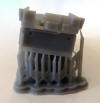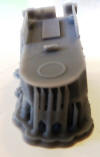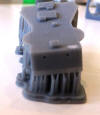Reviewed
September 2024
by Felix Bustelo |
|
| HISTORY |
|
|
Leading up to
and at the start of World War II, the Royal Navy had a serious shortage
of destroyers. A surplus of World War I era destroyers were scrapped and
tonnage limitations imposed by the 1930 London Naval Conference made the
shortage even graver. During World War I, destroyers provided the bulk
of ocean convoy escorts for the Royal Navy. However, the remaining vintage
destroyers were insufficient in numbers to perform escort duties for both
fleet operations and convoys. To address the gap in destroyers, a large
building program was initiated, but they were expensive to build, had lengthy
construction times and there were a limited number of shipyards capable
of building them. Also, there was a greater need for destroyers to screen
fleets and to carry out offensive actions against the enemy. With this
reality, it was necessary to construct escorts more suitable to act as
convoy escorts that would also be cheaper and easier to build with shorter
slip times. With these parameters, they could be constructed at shipyards
that had little to no experience building warships, thereby increasing
capacity. Within the broader class of merchant escorts, the terms “corvette”,
“frigate” and “sloops” were used to classify them. In addition, these ship
classes were generally not limited by treaty.
Beginning in the late 1920s, sloops were initially designed to be mainly
minesweepers. The two Bridgewater class ships, Bridgewater and Sandwich,
were launched in 1928 and were fitted with a large minesweeping winch at
the stern and armed with two 4-inch guns and two 3-pounder saluting guns.
They were also fitted with two depth charge chutes with four depth charges.
The Bridgewater class measured 266ft 4in long with a beam of 34ft 1in.
The next class of sloops, the four vessel Hastings class, were similar
to the Bridgewater class in terms of dimensions, machinery and armament.
The following group was the Shoreham class, built in two batches of four
ships each, but with a 15-foot longer hull and beam increased by 11 inches.
While larger than the preceding classes, as built Shoreham vessels had
only one 4-inch gun but two additional 3-pounder saluting guns. Of course,
during the course of the war, all of these ships had their armament and
ASW capabilities improved.
To address the need for minesweepers, the Halcyon class was designed
to be mass produced and cheaper to build. As a result, with the Grimsby
class, the main role of sloops shifted away from minesweeping to primarily
escort duties. While the hull length was reduced to that of the Hastings,
the beam was increased to 36ft. Due to the emphasis on escort duties, the
design armament was two 4.7in/45 Mark IX LA guns, a 3-inch HA gun and four
3-pounder saluting guns. For ASW purposes, four depth charges were fitted.
However, minesweeping paravanes and other equipment were still fitted.
Not all ships in this class received the design armament, with one ship,
Fleetwood, fitted with two twin 4in/45 Mark XVI guns. Also, as air defense
requirements increased, a shift was made to 4-inch guns, which had shell
that were lighter and easier to handle which in turn increased the rate
of fire. As the war progressed, the Grimsby class ships were fitted with
better AA armament and radar, HF/DF equipment and increased depth charge
loads. A total of 13 Grimsby class sloops were built between 1933 and 1940,
with eight commissioned in the Royal Navy, four built in Australia for
the Royal Australian Navy and one built in the UK for the Royal Indian
Navy.
HMS Deptford was laid down on April 30, 1934 at the Chatham Dockyard.
She was launched on February 5, 1935 and commissioned on August 15th of
that year. In 1939, two Vickers quad .50-inch machine guns were added.
With the outbreak of war, her depth charge capacity was increased to 40
and later 60 charges. A hedgehog ASW launcher replaced the 3-inch gun in
the B-position and several 20mm Oerlikons were added over time, two replacing
the quad Vickers.
Deptford was deployed to the Persian Gulf on commissioning and subsequently
in the Bay of Bengal and Singapore performing a variety of duties. With
the outbreak of World War II, Deptford performed convoy escort duties in
the Western Approaches and later in the North Sea and Mediterranean. In
December 1941, Deptford sank U-567 with depth charges during a convoy attack.
After completing repairs in March 1942, she joined the Freetown, Sierra
Leone convoy route and then supporting Operation Torch. For the remainder
of the war, she returned to the Mediterranean and lastly as a convoy escort
in the English Channel. In 1945, she was placed in reserve and sold for
scrap on March 8, 1948. |
| Starling
Models HMS Deptford |
|
| The Starling Models
HMS Deptford kit is comprised of cast resin hull, 3D printed parts, photoetch
parts, brass wire and a decal sheet. The kit represents Deptford in her
as built pre-war fit in an overseas station paint scheme. The contents
come in a sturdy flip-top box. The hull is enclosed in bubble wrap with
the 3D printed part rafts in either plastic sleeves or within small cardboard
boxes. The PE and decals are stored inside a clear plastic envelope with
cardboard backing. As an added bonus, two packages of Uschi brand elastic
rigging line are included in the box. |
|

|
 |
| HULL |
|
| The cast resin full hull is very nicely
done. The hull itself does not have a lot of fittings cast into it as they
are all done as 3D printed parts. The deck has planking that is realistically
done with realistic butt ends. The deck has a mix of raised sections, shallow
openings and scribed locations to accommodate the majority of the other
resin parts that fit into the deck. The hawse pipes at the foc’sle have
sufficient depth and do not need to be drilled out. The hull itself has
portholes, bilge keels and locator holes for the rudder and propeller shaft
struts. There is a remnant of a casting block along the keel that will
need to be sanded down if you are building it hull full. |
 |
 |
 |
 |
 |
 |
 |
 |
 |
 |
 |
 |
| 3D
Printed Parts |
|
| All of the 3D printed parts are gray
in color and come on rafts with thin attachment points for easy removal.
All of the 3D printed parts are very well done. Each raft as an assigned
letter to help identify it to the parts list in the assembly guide.
The two largest parts are the lower bridge and
aft gun deck structures. Both housings have portholes and square windows
with eyebrow and door openings. Again, these parts do not have too many
other details other than some skylights and raised sections and scribed
locations for smaller parts. |
 |
 |
 |
 |
 |
 |
 |
 |
 |
 |
| 3D
Printed Parts Raft A |
|
|
Raft A has the
upper bridge, funnel with separate funnel cap, breakwater, range finder
tub and searchlight platform.
|
|
|
| 3D
Printed Parts Raft B & B2 |
|
|
Raft B has 4.7in/45
Mark IX LA gun mounts, barrels and shields and the 3-inch HA gun. Raft
B also has the searchlight, anchors, rangefinder (with a spare), inclined
ladders and a brace that I think is part of the minesweeping equipment.
The smaller raft B2 has the anchor windlass, funnel vent piping and platform,
and aft storage racks.
|
|
|
| 3D
Printed Parts Raft C |
|
|
Raft C has the
bitts, fairleads, large and small mushroom vents, cable reels in three
different sizes and hatches fitted to the hull sides.
|
|
|
| 3D
Printed Parts Raft D1 & D2 |
|
|
Raft D1 has the
motor launch, two whaleboats and two dinghies, a pair of Carley floats
and paravanes. Raft D2 has cowl vents in four sizes with two of each provided.
Raft D2 also has boat davits in two styles, paravane davits, main mast
yardarm and tall vent pipe.
Somehow, one of the dinghies was missing from Raft D1. Apparently, it must
have broken off during packing the kit up. I contacted Mike McCabe, owner
of Starling Models, and several days later he replied and said he would
send a replacement. A couple of weeks later (keep in mind that Starling
Models is a one-man operation), a package with a 4-pack of 16ft dinghies
which are sold separately in the accessories range, arrived in the mail.
All I needed was one, so I now have three in the spares box – thank you
Mike! |
|
|
| 3D
Printed Parts Raft E1 & E2 |
|
|
Raft E1 has a
number of small parts, including ammo lockers, storage lockers, watertight
doors, propeller shafts with struts, crow’s nest, bridge fittings and other
detail parts. A few of the watertight doors broke off the raft and in a
senior moment, I neglected to include them in the photo. Raft E2 has the
propellers, rudder, 3-pounder saluting guns, individual depth charge roll-off
racks, additional lockers and fittings. Finally, there is a print raft
without an identifier with the minesweeping winch.
|
|
|
| PHOTO-ETCH |
|
|
Two
photoetch frets of different thicknesses with corresponding part numbers
etched into the frames are provided. The photoetch is nicely done with
relief etching. The larger but thinner photoetch fret contains all of the
railings, vertical ladders, mast ladders, square window hatches in open
or closed positions, storage racks, storage lockers, rigging eyes, stored
accommodation ladders and various other detail parts.
The thicker photo-etch fret as the searchlight platform supports, skylight
hatches, boat davit pulleys and some handling davits. Apparently, the part
numbers etched in the thicker fret are incorrect as the assembly guide
has an image with the corrected part numbers.
There are several parts on both frets that are not used with the Deptford
and are meant to be used with Starling’s other Grimsby class kit, HMAS
Yarra. |
|
|
| BRASS
PARTS |
|
|
Two
lengths of brass wire in two different diameters are provided. The thicker
wire is to be used for the masts and the thinner for yardarms.
|

|
| DECALS |
|
|
A
small decal sheet is included which provides the Union Jack and White Ensign
in two sizes each.
|

|
| RIGGING
MATERIAL |
|
|
Two
spools, for lack of a better term, of Uschi brand black elastic rigging
line are included, which is a very nice addition. I have never used this
product, so it will be interesting to try something new.
|

|
| INSTRUCTIONS |
|
|
The
assembly instructions come in a 16-page booklet which is among the best
that I have seen. The cover page has a profile view of the ship with general
instructions below. Pages 2 and 3 have an inventory of the resin and 3D
printed parts and the photoetch. The smaller 3D printed parts are grouped
by the print rafts they are on. As I mentioned above, the smaller photoetch
fret
image has the corrected part numbers. Resin and 3D printed part numbers
are within squares and the photoetch parts within circles to differentiate
them in the detailed assembly diagrams that adorn the following nine pages.
I did notice a few spots were either a part number was omitted or there
was a mix-up. For example, in the image showing the assembly of the funnel,
the vent piping parts, 21 and 22, were reversed in the image. Not a big
deal and does not take away for the how well done the instructions are.
The next three pages provide a very detailed rigging plan, which is a topic
not commonly covered in assembly instructions. One thing is that the photoetch
rigging eyes are part 6 and not part 2 as stated here. Again, not an issue
but something that I wanted to point out. The back cover of the booklet
has a 3D render of the completed model with full rigging.
The painting instructions are provided on what could be described as a
small poster rolled up in the box. The color references are for a pre-war
overseas station scheme of white hull with 507a upperworks, which would
make for an attractive model that will stand out among grayer ships in
a display. |
|
|
|
| FINAL
THOUGHTS |
|
| Overall, I find this to be a very
complete kit that will build into a detailed model of a pre-war as built
Grimsby class sloop. Research by the modeler will be required to see which
of the other ships in the class could be built in a pre-war fit. The kit
is very well detailed, though it is recommended for modelers with experience
working with 3D parts, some of which are tiny, and photoetch.
This kit is available directly from Starling
Models. |
